Pinterest Marketing isn’t just posting pictures. It’s using a visual search engine with real buying power.
Unlike trend-chasing platforms, it’s built for discovery and planning. Pins stick around for months or years, keeping content alive.
By mid-2025, Pinterest reaches 340M users via ads and 578M monthly globally. Marketing here isn’t posting pretty pictures; it’s about algorithms, visual search, and AI tools to reach users actively hunting ideas.
Evergreen, keyword-rich content wins.
Brands can repurpose assets, extend reach, and turn inspiration into action, often with lower competition and higher ROI.
Today, we’ll explore how Pinterest marketing works in 2025, why it matters, and how businesses can harness it for sustainable growth.
Pinterest Marketing at a Glance
Pinterest, with 578 million monthly active users, stands out among other platforms for its ability to turn inspiration into action.
Key Stats for 2025
What is Pinterest Marketing?
With Pinterest marketing, as a brand or business, you will get the opportunity to meet people at the very beginning of their discovery journey and then stay with them until they take a definitive action, like buying your product or service. Unlike social platforms built on fleeting engagement, Pinterest is a visual search engine where users actively look for ideas, inspiration, and solutions. Such functionality makes Pinterest powerful for businesses, as here, instead of trying to interrupt people with ads, you will be able to place your products and content where your audience is already searching for them.
Pinterest as a Visual Search Engine
Pinterest works like a hybrid of Google and Instagram. Users enter keywords, browse different categories, or let the platform’s visual recommendation system suggest something relevant. The process usually follows this path-
Inspiration – Users search for different ideas (summer outfit inspiration, DIY kitchen storage, etc).
Research – Then the users compare styles, check guides, and save boards
Purchase – Finally, they click through to product pages or shopping features to buy
The Pinterest algorithm analyze several factors to rank pins-
Relevance to search or query — Pinterest, as a visual search engine, functions like Google, and crawls Pin titles, descriptions, alt text, and board context
Image quality and engagement — Pinterest priotizes posts or “Pins” with clear visuals and higher engagement (saves, clicks)
Freshness of content — You will see new Pins more often on the feed, as Pinterest tends to keep its feeds dynamic
Personalization — Pinterest curates feeds based on the users’ past searches, boards, and interactions
Why Brands Use Pinterest
Pinterest attracts buyers who are driven by plans or ideas or a proper intention, unlike TikTok or Instagram. TikTok or Instagram often encourage purchases that are rather driven by impulses of the users, instead of plans. For example, someone might scroll TikTok, see a trending gadget, and buy it right away. In contrast, Pinterest users typically come to the platform with a plan in mind, for something like a wedding, holiday, or home renovation. It makes the Pinterest audience more deliberate and high-intent.
Also, Pinterest content has a longer conversion tail. A Pin can drive clicks for months after it has been posted. It’s a form of customer journey marketing, where brands guide users from awareness to purchase in a natural flow.
Why Pinterest Outperforms Other Platforms
Long content lifespan – Pins remain discoverable for months or even years
SEO visibility – Pinterest SEO combines keywords, visuals, and metadata for discoverability
High buyer intent – Pinterest users come with a plan in head and an intent to buy
Pinterest vs Instagram vs TikTok
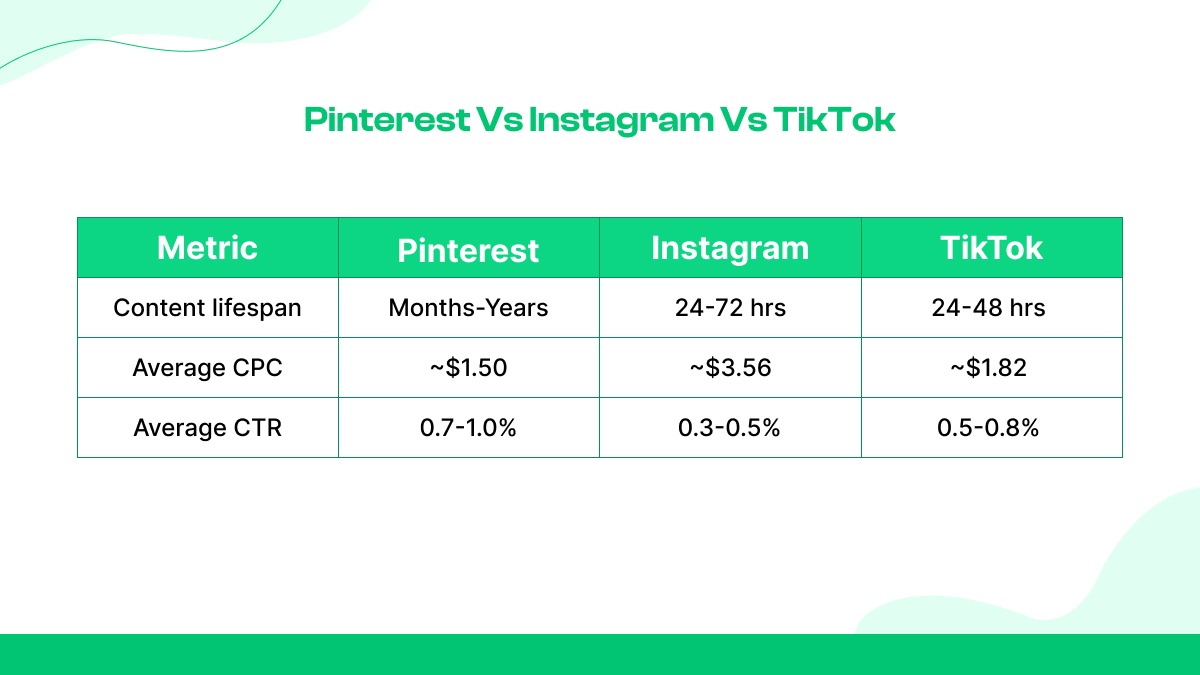
So, what kinds of businesses do best on Pinterest?
Lifestyle-driven industries — Fashion, beauty, home décor, travel, and food brands do great on Pinterest, as products from these industries are inherently visual and aspirational.
DIY, education, and niche crafts — Content or Pins that feature guides, infographics, and tutorials perform exceptionally well, as they answer queries that often come from intent-driven users.
E-commerce brands with strong visuals — Pinterest integrates directly with catalogs. It enables users to click through easily and shop.
Why choose Pinterest over Instagram?
Content longevity — Instagram posts fade within days, whereas Pins can surface in Pinterest search for months, or even years
Higher buyer intent — 83% of Pinterest users report making purchases based on branded content they find on the platform
Search-first discovery — Instagram’s search is secondary, while Pinterest’s entire experience is built on exploration and discovery-driven shopping
If you are looking to nurture long-tail discovery instead of chasing fleeting trends for your brand or business, then Pinterest can be a highly efficient platform for you.
Pinterest Business Setup (Getting Started)
If you have a well-set-up business account on Pinterest, it won’t only unlock special features like analytics and advertising for you, it will also make sure that your brand appears in searches and shopping feeds. Here’s how you can get started-
Creating & Optimizing a Business Account
A Pinterest business account gives you access to advanced tools like analytics, ads, and Rich Pins, which aren’t available in personal accounts. The process is very straightforward. Here it goes-
Step-by-step: How to create a Pinterest business account

As your business account is now active, you’re ready to claim your website and set up Rich Pins.
Claiming Your Website & Rich Pins
When you claim your website, it helps Pinterest figure out that you own your domain. Then it works to establish trust and ensures that your logo and brand name appear on every Pin linking back to your site.
How to claim your website on Pinterest (step-by-step):

What are Rich Pins?
Rich Pins automatically pull structured metadata from your site (like price, availability, or recipe ingredients) into your Pins. This way, it helps the Pins become more dynamic and informative, which leads to higher engagement and trust. For example-
Process of enabling Rich Pins-
Optimizing Your Pinterest Profile for SEO
Your Pinterest profile is basically like a mini landing page. If you optimize it, it will ensure that your account is discoverable both on Pinterest and through Google search.
Pinterest Profile SEO Checklist
If you manage to optimize your Pinterest profile in a proper way, it will become a search-optimized storefront for your business. This will lead to discovery and long-tail engagement.
6 Best Marketing Strategies to Follow on Pinterest
While the best tactics on Pinterest may vary based on niches, there are some universal strategies that are consistent in delivering results-
Prioritize Pinterest SEO
Treat Pinterest like a visual search engine, and use long-tail keywords to optimize your titles, descriptions, and boards.
Create viral-ready content formats
Test Idea Pins, video Pins, and eye-catching static designs to see what resonates most with your audience.
Organize boards strategically
Think of your boards like mini landing pages, structured around keyword-rich categories.
Balance seasonal and evergreen content
Post holiday campaigns in advance, but keep evergreen resources (guides, tutorials, how-tos) active all year.
Leverage analytics and trends
Make sure to leverage Pinterest Trends and in-platform analytics and adapt your content calendar around what users are searching for right now.
Integrate shoppable features
Enable Rich Pins, product tagging, and catalog uploads.
Apply these strategies consistently to make sure that they bring out the best results for you. The idea here is to treat Pinterest less like a fast-scroll social feed and more like a long-term discovery and content marketing engine.
Pinterest SEO & Content Strategy
Being found on Pinterest by your intended audience comes down to mastering both search optimization and content design. Here’s how you can build a strategy that balances keywords, visuals, and structure.
Pinterest Keyword Research & SEO
On Pinterest, keywords will work as your compass. They guide the algorithm in matching your content with what users are actively searching. Unlike Google SEO, where competition for keywords can be fierce, Pinterest allows for more long-tail targeting.
To use Pinterest keywords effectively-
Pinterest SEO vs Google SEO:
Pinterest SEO focuses on relevance + engagement (keywords + visuals + user actions). Meanwhile, SEO for Google focuses on backlinks, authority, and text-heavy signals.
That being said, SEO for both these platforms benefit from long-tail keyword targeting, even though Pinterest SEO is driven more by visuals and intent.
Designing Viral Pins (Static, Video, Idea Pins)
Content design is the lifeblood of Pinterest success. The platform currently supports different content forms, such as static Pins, video Pins, and Idea Pins.
What size should Pinterest Pins be in 2025?
Idea Pins vs. Standard Pins — which performs better?
Board Organization & SEO Hierarchy
Boards are more than just content folders. They act as thematic landing pages for your brand. Optimized boards boost your content’s chances of ranking in Pinterest search. Here’s how you can optimize your Pinterest boards for SEO-
Best way to organize boards-
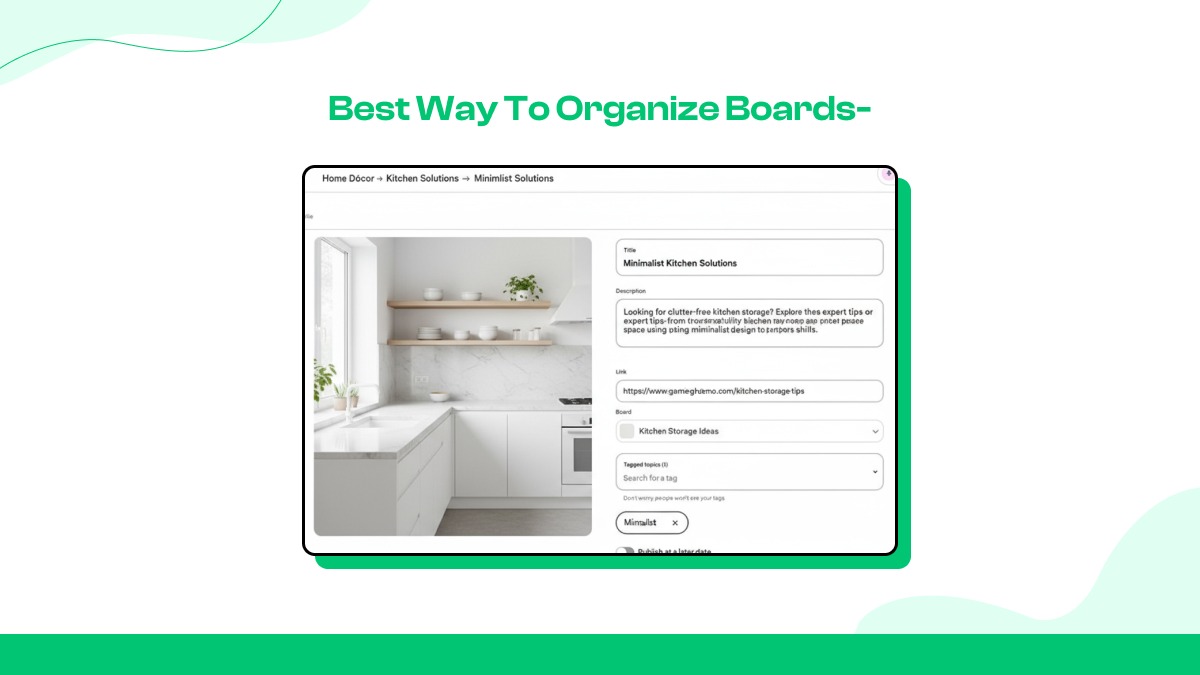
Seasonal & Evergreen Content Strategy
Timing matters on Pinterest. Seasonal searches can spike months before a particular event. But evergreen content ensures you’re discoverable year-round.
Here’s how you can use Pinterest for seasonal campaigns-
Pinterest for evergreen blog repurposing:
The best content strategies create a balance between seasonal spikes and evergreen Pins. This helps with both short-term engagement and long-term visibility. Together, they form a content lifecycle marketing approach and manage to leverage Pinterest as a continuous funnel for discovery and conversion.
Pinterest Advertising & Funnel Strategies
It’s great if you can have organic growth on Pinterest, but paid promotions can help you scale faster, especially when it comes to reaching highly specific audiences at various stages of the customer journey. Pinterest Ads are unique, as they seamlessly blend into the platform’s discovery-driven experience, often appearing as natural content instead of intrusive banners.
Pinterest Ads Manager Setup
First, you’ll need to set up Pinterest Ads Manager if you’re looking forward to starting advertising. It will centralize your campaign creation, targeting, and performance tracking. Here’s how you can set it up step by step-
Pinterest Ad Formats
Standard Pins (Promoted Pins): These Pins appear like organic Pins, and they are best for awareness and traffic
Video Pins: Motion-based ads. They are ideal for engagement and storytelling
Idea Pins Ads: Multi-frame and immersive format; helps boost interaction and saves
Shopping Ads: Pull product catalog data into shoppable Pins with price/availability
Carousel Ads: Multi-image slides. They are great for showcasing product collections
Collection Ads: Hero image + product tiles; optimized for shopping experiences
Funnel-Based Pinterest Strategies
Pinterest aligns with the marketing funnel naturally, as users start with discovery and move toward purchase intent.
Top-of-Funnel (TOFU) – Awareness & Discovery
Middle-of-Funnel (MOFU) – Consideration & Engagement
Bottom-of-Funnel (BOFU) – Conversions & Retargeting
ROI & Competitive Comparisons
Pinterest Ads vs Facebook Ads ROI
On Pinterest, average Cost Per Click (CPC) is $0.10–$1.50, depending on industry. Meanwhile, the average CPC on Facebook is $0.50–$3.00. At the same time, Pinterest tends to outperform Facebook in e-commerce, lifestyle, home décor, food, and fashion niches, thanks to its planning-driven audience
Pinterest vs Instagram Marketing Effectiveness
Pinterest excels at long-tail conversions, as Pins continue to drive traffic long after posting. On the other hand, although Instagram often wins at brand awareness and influencer campaigns, it has a much shorter content lifespan.
Also, Pinterest’s buyer intent is higher, with 83% of weekly users making purchases based on Pinterest content.
ROI Benchmarks by Industry (2025)
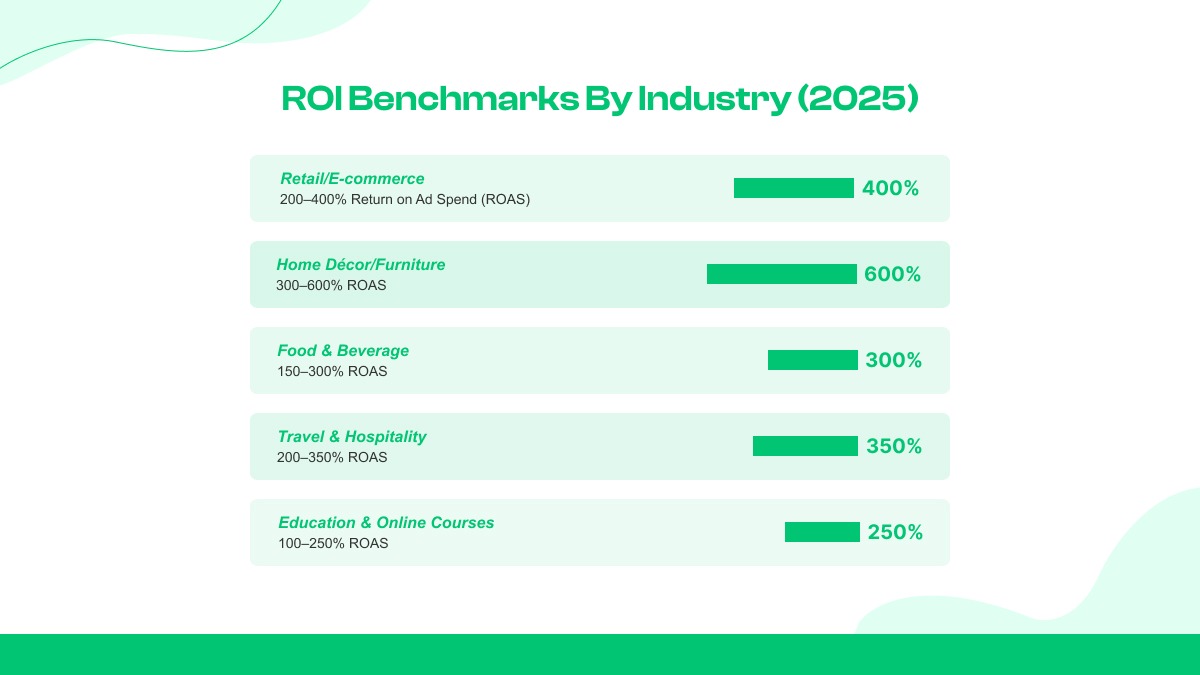
Pinterest ads deliver lower Cost Per Click and higher return on ad spend in niches that are heavy on planning and visuals.
Pinterest Analytics & Performance Tracking
For Pinterest marketing, it’s paramount to understand the analytics and performance tracking on the platform.
Understanding Pinterest Analytics Dashboard
Pinterest Analytics comes with a central dashboard, where businesses can measure how their content performs, regarding impressions, saves, clicks, and conversions.
To access analytics: Go to your Pinterest Business Hub → Analytics → choose Overview or Audience Insights.
Key features:
Tracking conversions from Pinterest traffic requires installing the Pinterest Tag on your website. It monitors customer actions like add-to-cart or checkout, feeding performance data back into the Analytics dashboard.
KPIs to Measure Pinterest Success
Not all metrics carry the same weight. Success depends on matching KPIs to your goals (brand awareness vs sales).
Suggested KPI Table:
CTR benchmarks on Pinterest usually fall between 0.7–1.2%, but high-performing niches (fashion, food) often exceed 2%.
Pinterest Marketing by Industry (Niche Strategies)
Let’s have a look at Pinterest marketing by industry.
Pinterest for E-commerce & Retail
Shopify Stores: Connect your Shopify site directly to Pinterest to auto-sync products as Pins. These Pins update pricing and availability of products in real time
Pinterest Catalogs: Bulk upload product feeds to create shoppable Pins with product details and dynamic pricing
Amazon Sellers: Repurpose Amazon product imagery into Pins with lifestyle mockups → direct link to listings
Pinterest for Bloggers & Creators
Affiliate Marketing Tips: Use disclosure-compliant Pins with affiliate links. Rich Pins ensure pricing and metadata stay accurate.
Lifestyle Bloggers: Share seasonal and evergreen content (recipes, guides, checklists) with Idea Pins for tutorials and Static Pins for blog traffic.
Cross-promote blog content: Each blog post → 3–5 unique Pins with varied titles & graphics.
Pinterest for Fashion, Food, Travel, and Coaches
Pinterest thrives in visual-first niches, like-
Fashion: Outfit ideas, seasonal lookbooks, styling tips.
Food: Recipes, meal prep, holiday guides (major driver of saves).
Travel: Destination guides, itineraries, “bucket list” boards.
Coaches (life/fitness/business): Infographic Pins, motivational Idea Pins, and lead magnets (free guides).
Pinterest Tools, Automation & AI
Mastering Pinterest marketing isn’t just about creative content and SEO. It’s also about the right tools, automation, and leveraging AI or visual search so that you can efficiently scale your efforts.
Top Pinterest Marketing Tools
Most marketers depend on scheduling, analytics, and keyword tools to stay consistent and organized. Here are some top picks and a comparative breakdown.
Best Pinterest scheduling & keyword tools-
Tailwind: A longtime favorite and official Pinterest Marketing Partner. It’s built specifically for Pinterest scheduling and analytics. This tool’s smart queueing, interval scheduling, and integration with Canva make it efficient for batch Pin creation.
Buffer: A more general social media scheduler that supports multiple platforms, including Pinterest. It’s often praised for its simplicity and cross-channel flexibility.
Native Pinterest Scheduler: Pinterest itself offers built-in scheduling for business accounts, which is a reliable fallback and sometimes preferred for “native” delivery.
Keyword/Trend tools:
Comparison Table
AI & Emerging Features in Pinterest Marketing
AI, visual search, and AR (augmented reality) are shaping Pinterest in present time, making it more than just a static image board.
This is how AI tools improve Pinterest marketing-
Multimodal search / visual + text fusion: Pinterest now combines image and text signals for search. Users can click on a Pin and then refine by object or keyword.
Improved ranking & embedding models: Algorithms like OmniSearchSage help Pinterest better understand queries, Pin content, and image-product relationships, improving relevance and engagement.
Smart suggestions & automation: AI-assisted suggestions for titles, descriptions, alternate visuals, and trend picks can speed up content production.
AR / visual search trends:
Marketers who adapt to AI early will reap the advantage of better personalization, smarter content ideation, and deeper insights.
Advanced Pinterest Marketing & Monetization
Once your Pinterest strategy is mature, these advanced paths help turn content and traffic into revenue.
Affiliate Marketing & Digital Products on Pinterest
How to use Pinterest for affiliate marketing in 2025
Using Pinterest to sell digital products
Pinterest for B2B vs B2C
You may wonder whether Pinterest is better for B2B or B2C. To answer that plainly, historically Pinterest has favored B2C, especially in visual, lifestyle, and retail niches (fashion, home, food).
However, B2B can also benefit when your content is visual and educational, such as agencies, SaaS, marketing tools sharing infographics, guides, or case studies. The trick is reframing your B2B content as aspirational or actionable (e.g. “Office design trends for startups,” “Remote workspace fundamentals”).
Pinterest Influencer & Creator Economy
Brands can partner with creators to produce Pins, Idea Pins, or shoppable content collaborations. At the same time, Pinterest also runs a creator program / creator rewards, which is specific to certain regions and subject to eligibility, for high-performing creators.
Moreover, Pinterest recently announced a partnership with LTK (a major influencer shopping/affiliate platform), automatically pushing influencer content into Pinterest feeds.
On Pinterest, Creators can monetize via-
Brands can extend reach in more authentic and content-native ways by aligning with creators.
Pinterest Marketing Challenges & Problem-Solving
Even though Pinterest can be one of the most rewarding platforms for long-term marketing, it comes with its fair share of hurdles. Many businesses struggle with traffic plateaus, low engagement, or account restrictions.
However, don’t worry, as most issues have straightforward solutions once you know where to look.
Common Pinterest Marketing Mistakes
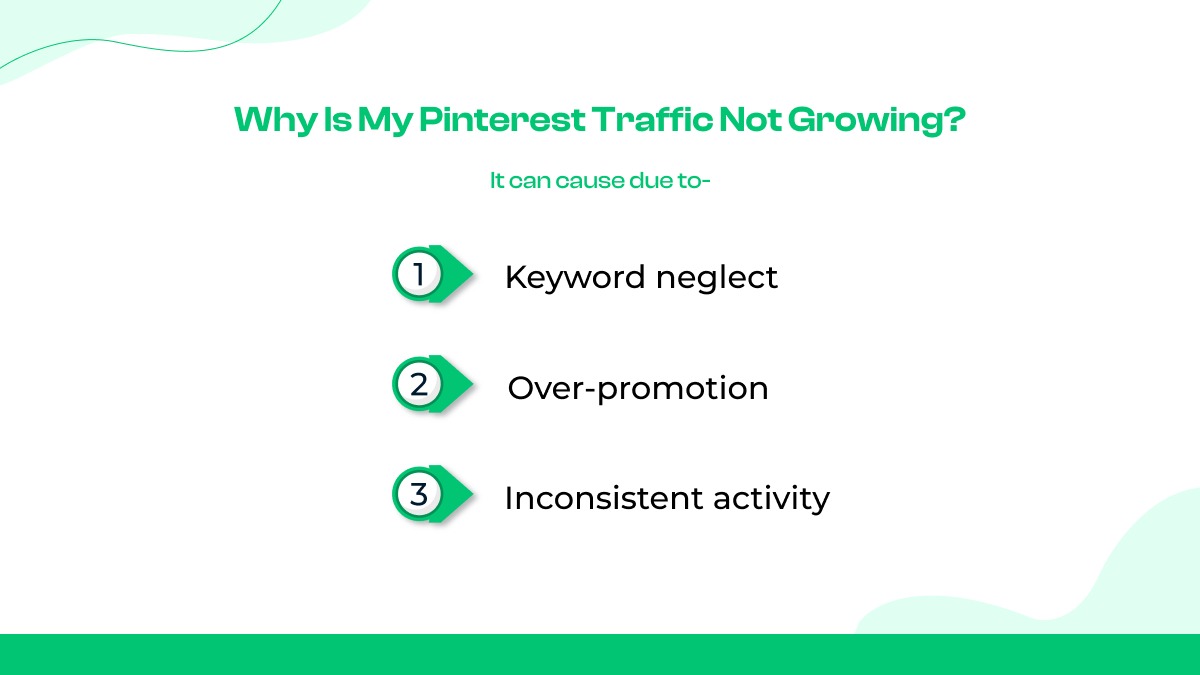
One of the most common issues marketers face is: “Why is my Pinterest traffic not growing?” It can cause due to-
Another challenge creators face is – “Why are my Pinterest ads not converting?”
Many campaigns fail because they target too broad of an audience, which doesn’t align with Pinterest’s intent-driven audience.
Also, ad creatives may fail to match user search intent. For example, promoting a generic product photo instead of lifestyle context (showing the product in use) often results in poor conversions.
Fixing Engagement & CTR Issues
If your Pins are getting impressions but low engagement, here’s what may help-
When it comes to CTR (Click-Through Rate)-
Pinterest’s average CTR varies by niche, but anything above 0.7%–1% is considered good.
Account & Policy Issues
Sometimes, issues go beyond content strategy and into account health.
If your Pinterest account gets suspended, in order to recover it first go to Pinterest’s appeal form and submit details. Suspensions often take place for spammy behavior (repetitive content, link cloaking, or copyright complaints). If it’s a mistake, providing evidence usually resolves it.
There are some ad policy restrictions on Pinterest. Ads are not allowed for certain categories like tobacco, adult content, unsafe supplements, or misleading financial schemes.
To avoid facing such issues on your account, stay updated on policy changes. Also, avoid shortcuts like keyword stuffing or automated spammy pinning.
Grow Your Pinterest Channel with Socialplug
Once your Pinterest marketing strategy is in place, the next things you need for efficient scaling are automation and smart engagement. That’s where tools like Socialplug come in.
Socialplug can help you with-
Kickstart your growth journey on Pinterest with Socialplug:
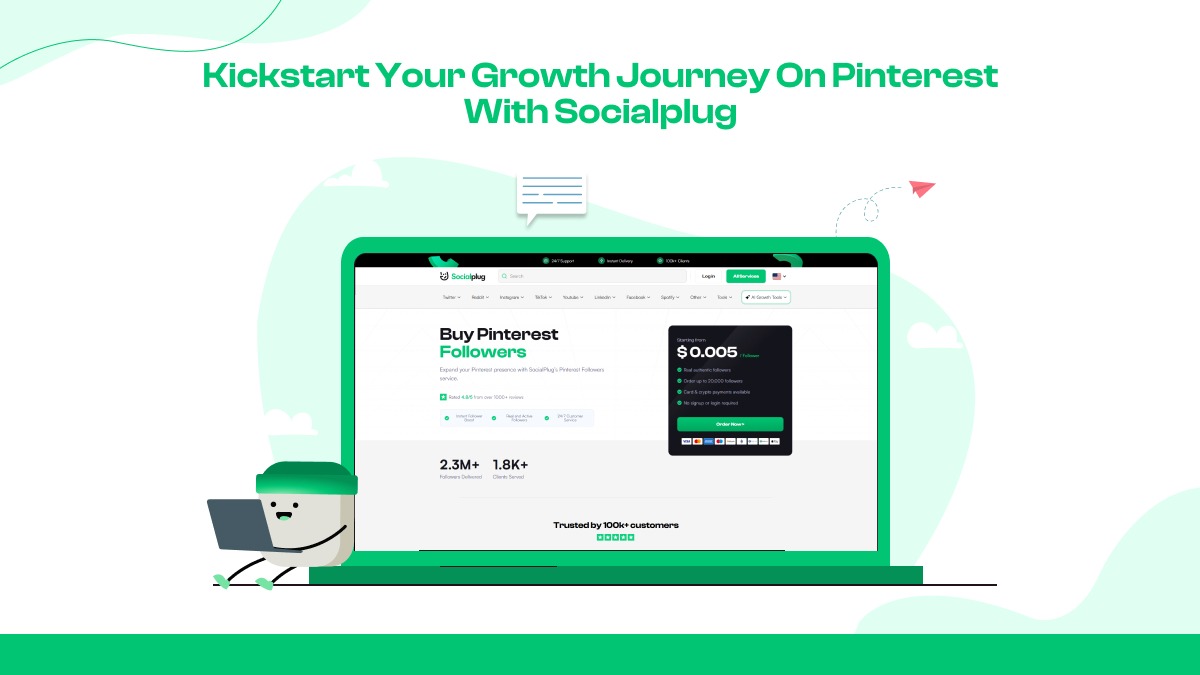
We can help maximize your reach effortlessly. This will allow you to focus on creating high-quality content, while distribution and engagement run smoothly in the background.
Frequently Asked Questions

As per studies, posting during evenings and weekends works best, especially 8–11 PM local time. However, the algorithm prioritizes quality over timing, so consistent posting matters more than exact hours.
Idea Pins often get more reach, as Pinterest promotes them heavily.
Absolutely. With organic reach being strong and content having a longer shelf life, even small brands can build traction with consistent pinning and optimized SEO.
Optimizing descriptions with natural language queries can help you capture voice-driven searches, as Pinterest integrates with mobile voice search and uses alt text, keywords, and image recognition.
Home décor & DIY, Fashion & beauty, Food & recipes, Travel & lifestyle, Health & fitness, and Personal finance & side hustles.
Pinterest uses AI models like OmniSearchSage to personalize feeds and search results.




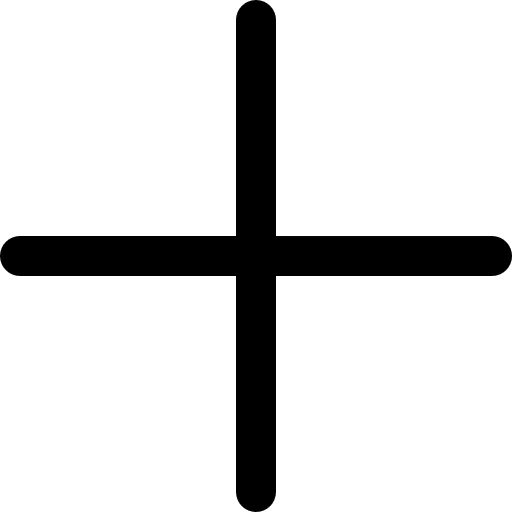


.svg)
.svg)








0 Comments
Great tips! I never realized how much engagement impacts growth more than just posting frequently. I've been focusing only on content, but now I see how interacting with my audience can make a difference. Time to step up my strategy!
Super helpful article! I always thought Facebook Groups were just for discussions and never really considered them as a tool for growing followers. The idea of actively engaging and sharing valuable content in relevant groups makes so much sense. I'll definitely start participating more and see how it impacts my page. Thanks for the great advice!